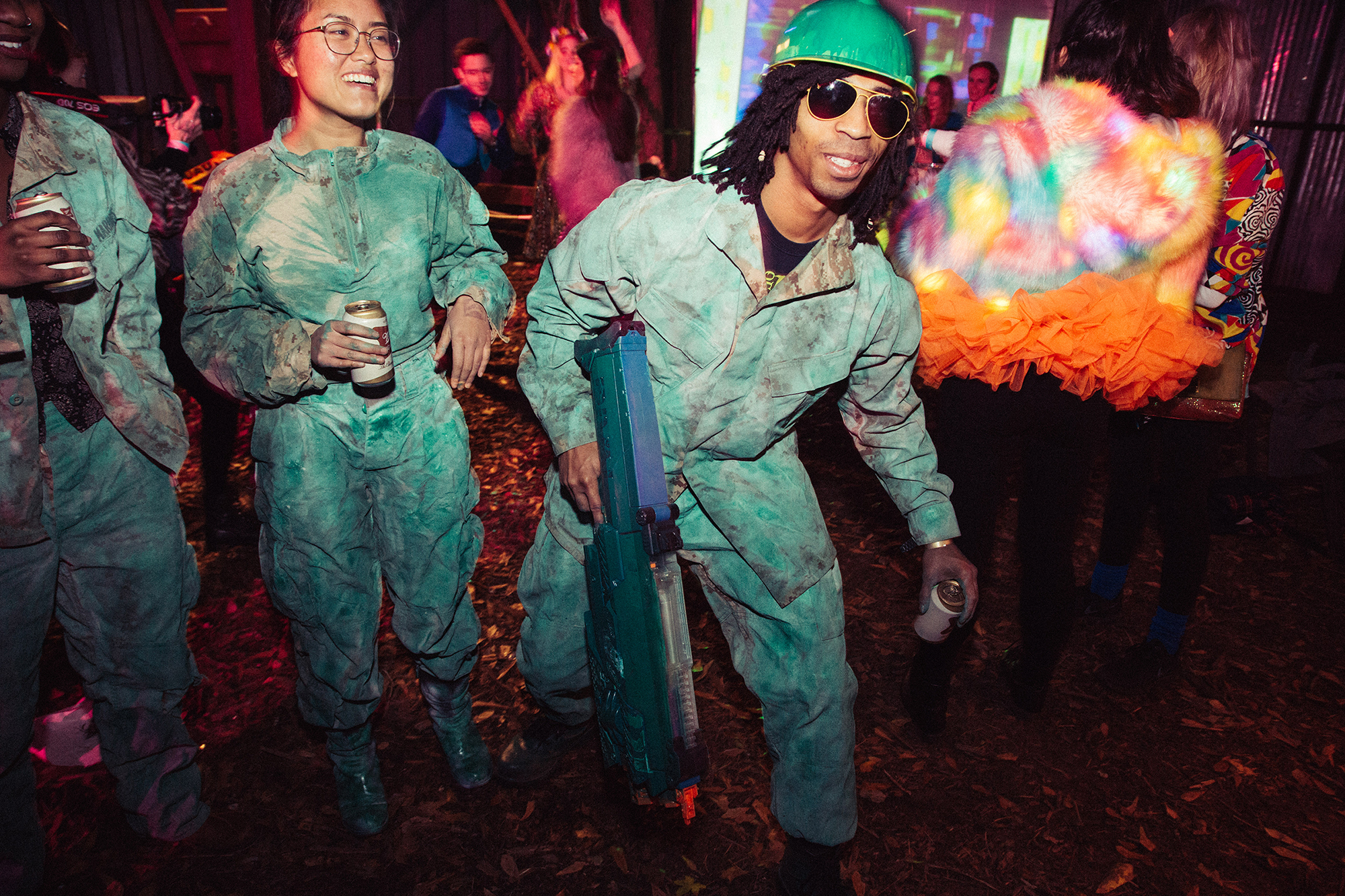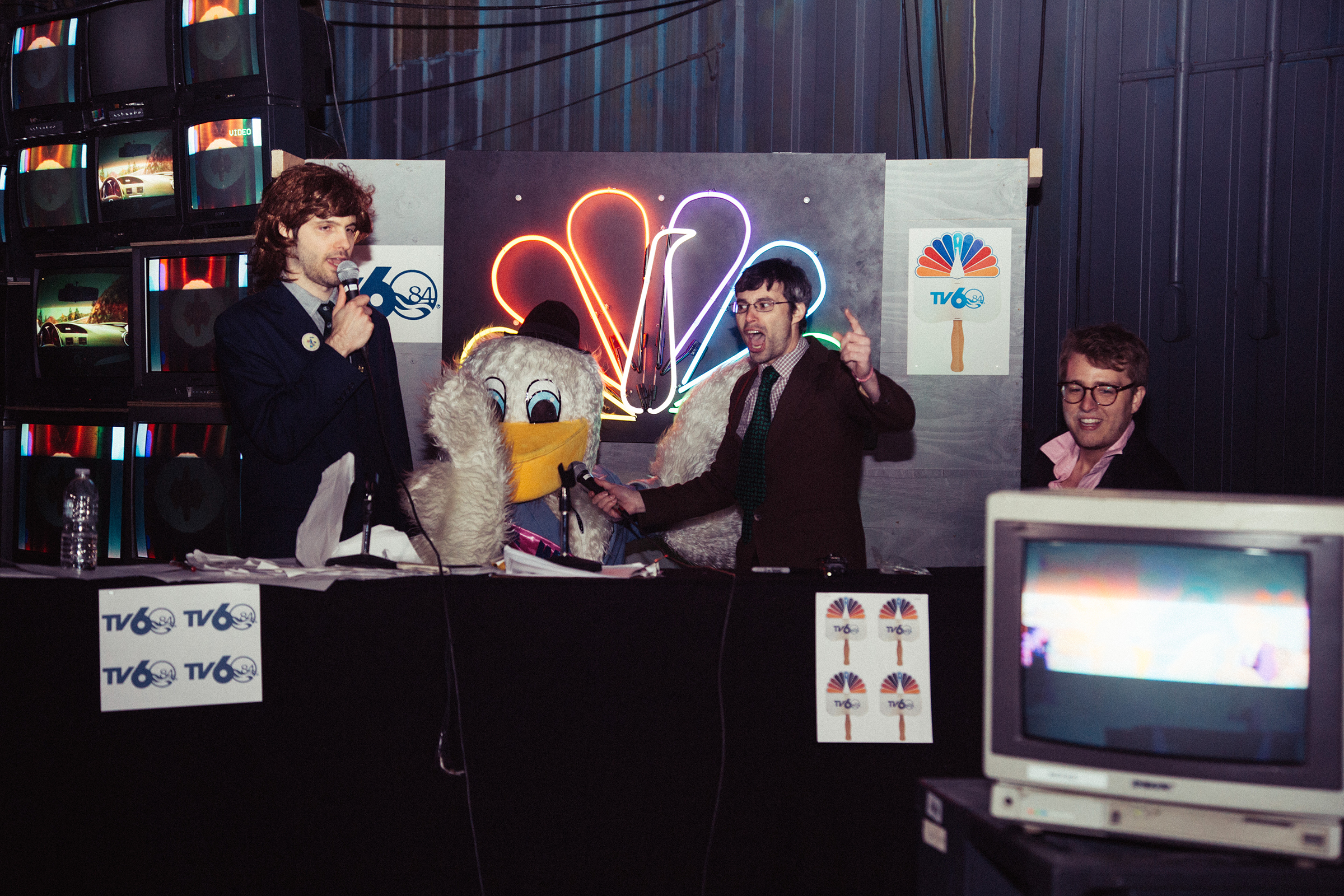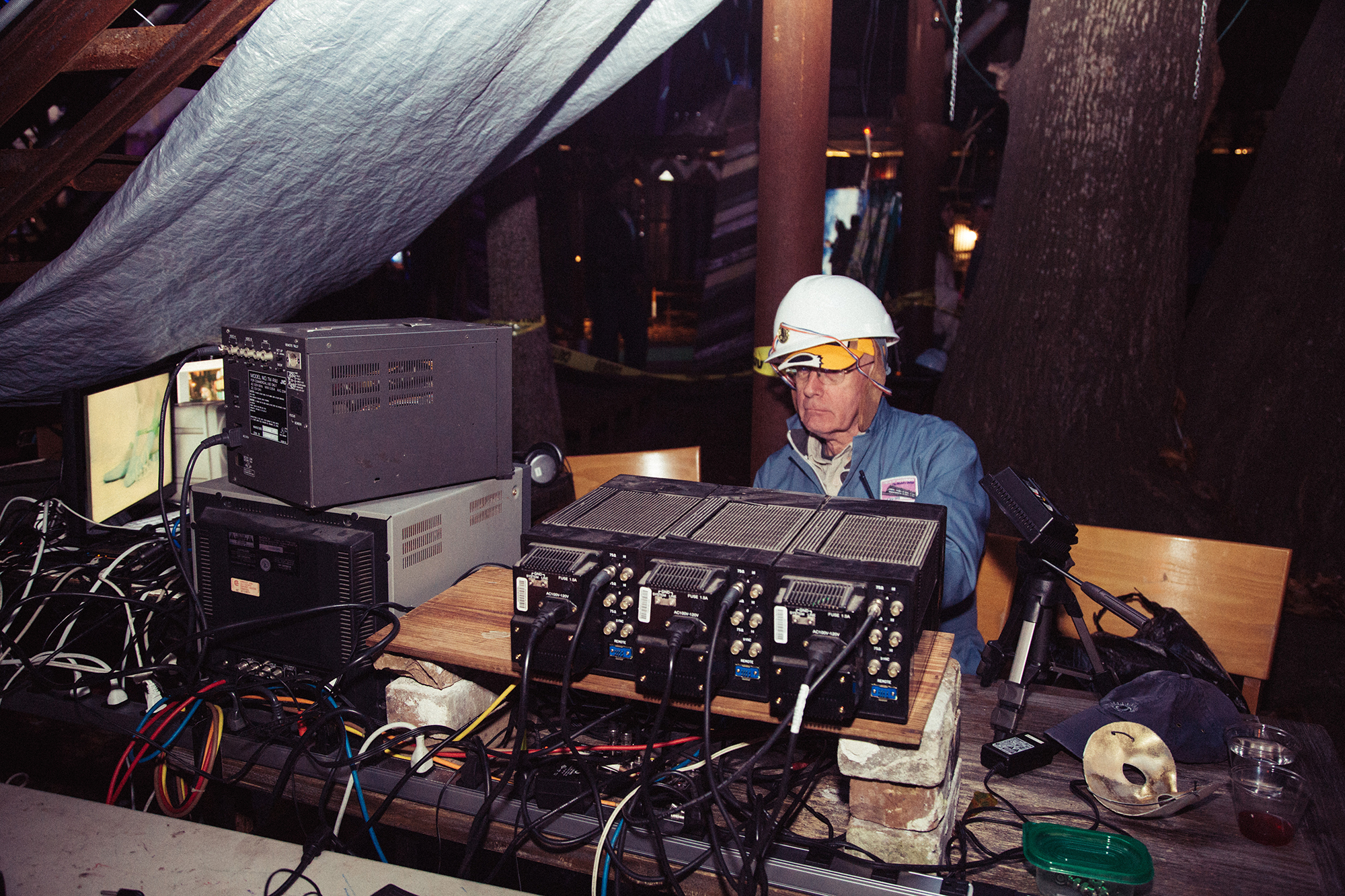It was on a friend’s floor that Clairissa Mulloy found the laser disc she wore tied above her head like a charming sunhat – better than a CD. “More coverage,” she explained. And looking out over those dancers from an upper balcony, Nisey Shanks fluttered her eyelashes so they glowed blue – the deep cobalt of a screen with the input off. She had bought the motion-sensitive LED-strip lashes more than a year ago by supporting the project on Kickstarter, but they had only arrived that morning. “A sign,” she said.
36 cathode ray tube televisions were lined up in homage to the 1984 World’s Fair’s “Wonderwall”, a sculpture that mimicked a stationary Carnival parade with another form of stationary amusement – the television. Members of the Krewe of Vaporwave worked online as a group to dig up and program the old video content that ran through the monitors all night, including shots from Fern Gully, informational videos, and police footage. Photo: Akasha Rabut.
Behind her, a projector broadcast a Windows screensaver against a 6m-wide wall. Thirty-two cathode ray tube televisions flashed old clips of Fern Gully between tutorials by the US Geologic Survey. Couples stood in a line to mix VHS channels in real-time, turning a video of their faces green and pink and black. And in a wooden booth lined with mirrors and ceilinged in cameras, a man with a CD taped on a hard hat gyrated slowly, then emerged to watch his own performance – delayed by a TiVo, now blaring back at him from a teetering stack of television monitors.
This is the Carnival Ball for the Krewe of Vaporwave – a “krewe” being the local lingo for one of more than 40 private clubs whose members tug their parades through the city streets over the weeks ahead of Mardi Gras; and Vaporwave being the term for a musical genre born on the internet that came to embody a broader aesthetic movement, a cross-stitching of cultural symbols that, like Mardi Gras itself, mocks power and makes clear life’s absurdities. Unlike traditional Carnival krewes that toy with aristocracy by plucking debutantes to serve as “queens”, the Krewe of Vaporwave sends up a power structure that does more to rule our lives these days: The power of screens.

The ball drew 600 people to The Music Box Village in New Orleans, to physicalize a movement born on the internet. The costume prompt – “Pink and Teal, Summer and Sea, Eternal Vacation” inspired looks that nodded to Vaporwave’s aesthetic blend of old technology and gauzy escapism. Photo: Akasha Rabut.
Founded in 2015 and organised over the internet (Craigslist ad, Reddit post, Google Shared folder) the group touts itself as the “first and only virtual Mardi Gras krewe”. Its parades can only be viewed in pixels: As a multiplayer video game available for download this year on February 6, a broadcast on Twitch, or a recording taped onto VHS and sold at the ball for $US12 ($15).
The concept pays homage to Vaporwave, an online movement that coalesced as YouTube users chopped, slowed and spliced found audio in resistance of the site’s anti-pirating algorithms. Producers such as Ramona Xavier and James Ferraro gradually pushed their idea toward a cohesive sound – a pastel, neon wash that shimmered like an oasis above a dry critique of capitalism. Like Dada artists who repurposed the commercial flotsam of the past with scissors and glue, the collage of soulless muzak, retro advertising and commercial pop reflected a culture at peak absurdity. For a generation that plumbs the attics of their fathers not to discover war relics or antique trunks but rather old computers, Vaporwave serves as nostalgia and resistance: An homage to old technology, a re-taking of its control.
The event’s dress-code included the costume prompt – “Your grandma’s AOL address” – and ballgoers looked to old tech for inspiration. Elizabeth Seleen reused tape from inside a VHS of Bridget Jones’ Diary; Jesse Shamon wore earrings inspired by Microsoft Word’s “Clippy” and her boyfriend Sam Baker looked to the “jazz” design of a Dixie cup. A vaporwaver who goes by the pseudonym “Happiness Is” simply plopped a CD on his hard-hat. Photos: Akasha Rabut.
“In that early TV-centered society, you were at the mercy of what was put on screen,” said Rachel Lin Weaver, a professor in the School of Visual Arts at Virginia Tech who teaches courses on video art, and came to the ball to run a mapped projection on a wall of spiky tetrahedrons. “We are so bombarded now. But Vaporwave references those earlier eras, the times when we could have still made a change.”
“It’s about the deep sadness of the internet,” said Win Butler, the Arcade Fire frontman and recent New Orleans transplant who DJ-ed under his latest pseudonym, Windows 2000, spinning analogue vinyl of Whitney Houston’s 1992 “I Will Always Love You” and Washed Out’s “Feel it All Around” – a remix of a 1983 Italo-disco hit. In a crowd twisting below the DJ booth, Jesse Shamon wore a costume inspired by the program Microsoft Word, with the red zip of a spell-check underline painted on an eyebrow and earrings meant to look like the program’s How To host, the infamous Clippy. “As technology gets more threatening, we’re nostalgic for our humble beginnings, for a more docile precedent,” she said. “We’re quickly getting more Black Mirror than clip-art.”

Arcade Fire frontman Win Butler worked the party as DJ Windows 2000 – an upgrade from his former name Windows 98. “It’s a more secure operating system,” he joked. The New Orleans transplant played a set that flipped between nostalgia for the recent past and the overstimulation of our present, with Future’s “Mask Off” playing its chorus of “Molly Percocet” after Whitney Houston’s 1992 “I Will Always Love You”. Carnival to him? “It’s a very healthy inversion of societal norms where people get shit out of their system.” Photo: Akasha Rabut.
The party Friday at The Music Box Village in New Orleans’ quickly gentrifying Bywater neighbourhood drew about 600 people, according to the venue, but is only the group’s second ball. The first, dubbed the “IRL Ball”, drew 250 of the city’s growing class of artistic transplants out to a rented Daiquiri shack for headliner LilInternet, a Brooklyn DJ who is best known to Vaporwavers for inspiring a goofy dolphin-stuffed subset of the movement known as “seapunk”. “The vibe I got was ‘singularity kitsch’,” he said. “And a knowing, winking celebration of the self-awareness of our slide into hyper-reality.”

The party was broadcast live on YouTube by comedians in the Special Features improv troupe, who re-created a cringe-y four hour broadcast of the fair’s opening day. Josh Shreve annotated like a reporter breaking down amid chaos as Scott Anderson held a microphone up to the party’s mascot, “Seymore D. Icks”, a mockery of the fair’s fluffy pelican avatar Seymore D. Fair. Nearby, Sam Moody took a break from anchor duty to laugh at the feed on a live monitor. Photo: Akasha Rabut.
This year’s party had a more pointed target. Dubbed “The World’s Unfair”, the ball parodied the 1984 World’s Fair in New Orleans that, like other global expositions, aimed to sell visitors on the promise of a connected future. Booths repping countries and corporations from Canada to Chrysler advertised potential innovations. But the very human failures of the present rocked their arguments. It was the first World’s Fair to go bankrupt over the course of its run, as a group of Louisiana businessmen mismanaged it into the ground before the state stepped in. But contractors never got their full paychecks. And minutes after blessing a $US10 million gondola ride, the Archbishop of New Orleans boarded a car, headed across the Mississippi, and lurched to a stop as the ride broke on its inaugural run.

The party themed “The World’s Unfair” was a loving parody of the first World’s Fair to go bankrupt over the course of its run — the 1984 World’s Fair in New Orleans. Partygoers feasting on a mix of nostalgia and mockery could board an original gondola car from the $US10 million World’s Fair ride that infamously broke down over the Mississippi with the city’s Archbishop on board. Photo: Akasha Rabut.
One of the original gondola cars was on view at the party; a rented kiddie train was transformed into the fair’s monorail, and a local improv troupe that specialises in critiques of video technology – Special Features – recreated a cringe-y four-hour live broadcast filmed on the fair’s opening day.
“I just love the idea of something so grand that just fails so horribly,” said Visqueen, a member of the drag trio High Profile, who closed out the ball by stripping to lip-synched Vaporwave remixes of George Michael songs, deploying oversized mobile phones, a mountain of fake cocaine (flour), and printouts of the singer’s face atop their jiggling rears in a goofy send-up of celebrity.

The krewe’s membership includes a former television news director who goes by the pseudonym, Swen Now. He was enlisted to be a very real news director Friday night, as he manned live feeds for a parody broadcast of a local television station’s coverage of the fair’s opening day in 1984. Photo: Akasha Rabut.
“This is a living meme that’s also a Mardi Gras organisation,” said Max, a 15-year-old who joined the krewe after he was dragged along by his 50-year-old uncle. “It’s literally the internet.”
Only his uncle, who goes by the pseudonym Transceiver, didn’t see all that much new about Vaporwave. A tech designer who wired early social experiments about the internet for Josh Harris, the tech millionaire captured in the documentary We Live in Public, he only learned about Vaporwave at a recent maker faire. “Once it was explained to me what Vaporwave really is, I said, ‘I’ve been doing that forever.’”

Krewe member Transceiver pulls out his creation – an homage to the advertising billboard trucks that roll through New Orleans. He used 48 monitors donated by a private school, 48 Raspberry Pi computers, and the program info-beamer – which runs off his mobile phone – to change the content in real time, so the videos can comment on what’s nearby. Photo: Akasha Rabut.
For the ball, he affixed 48 donated computer monitors to the outside of a truck, controlling them with 48 Raspberry Pi’s via an iPhone app that let him flick through videos in real-time. Krewe members followed his lead to an after party at a former storefront church nearby, where the krewe’s captain closed out the night with a performance of his rap group.
As a DJ behind him sampled a guitar riff, the 37-year-old Harvard-educated religion major picked up a white, plastic controller from the game Guitar Hero and, windmilling his arms, stroked the toy as though it could make real music, smashed it as though he could foment a real revolution.
“If there’s anything I do that could leave blood on the walls, it’s this,” he said.